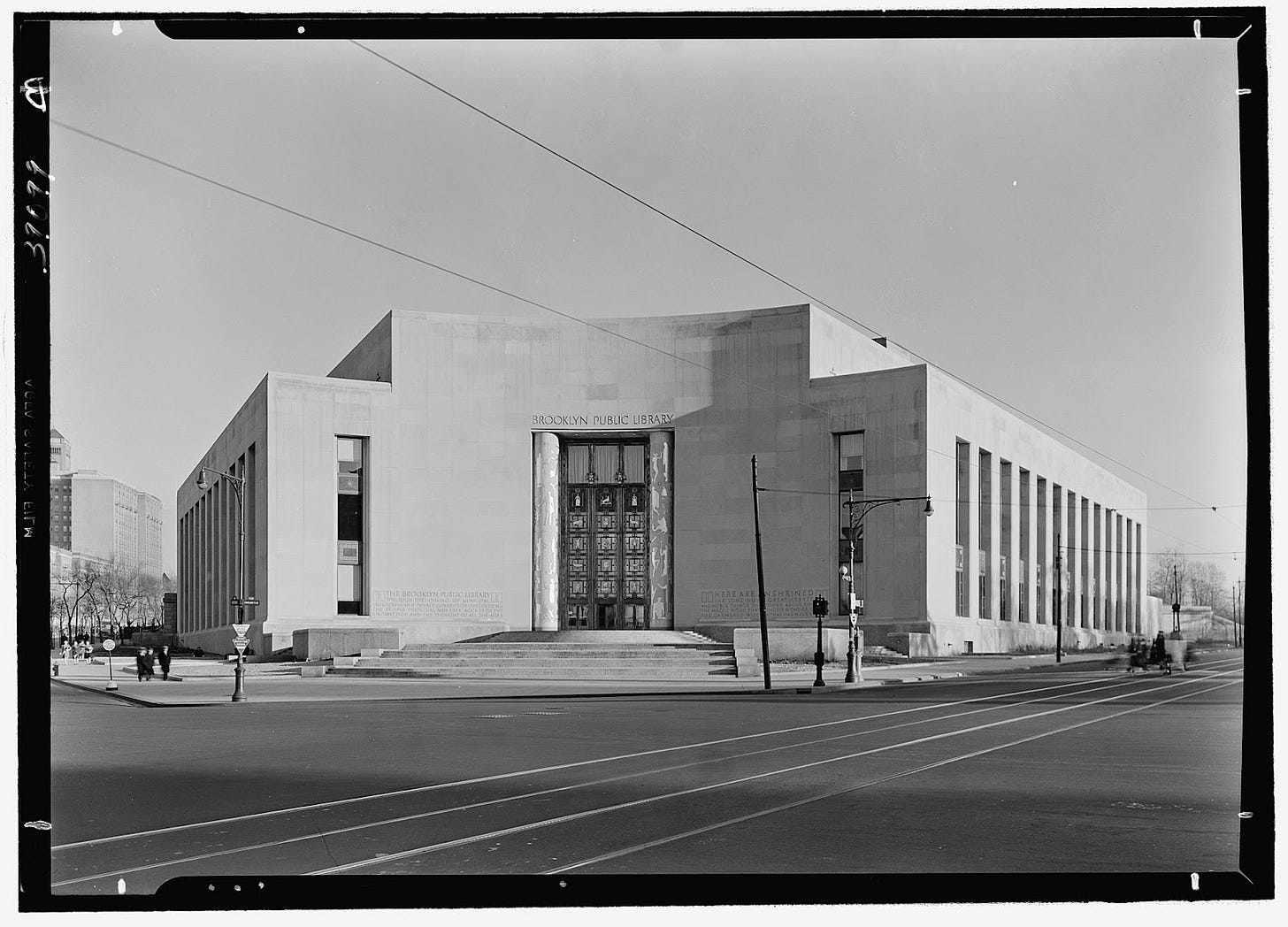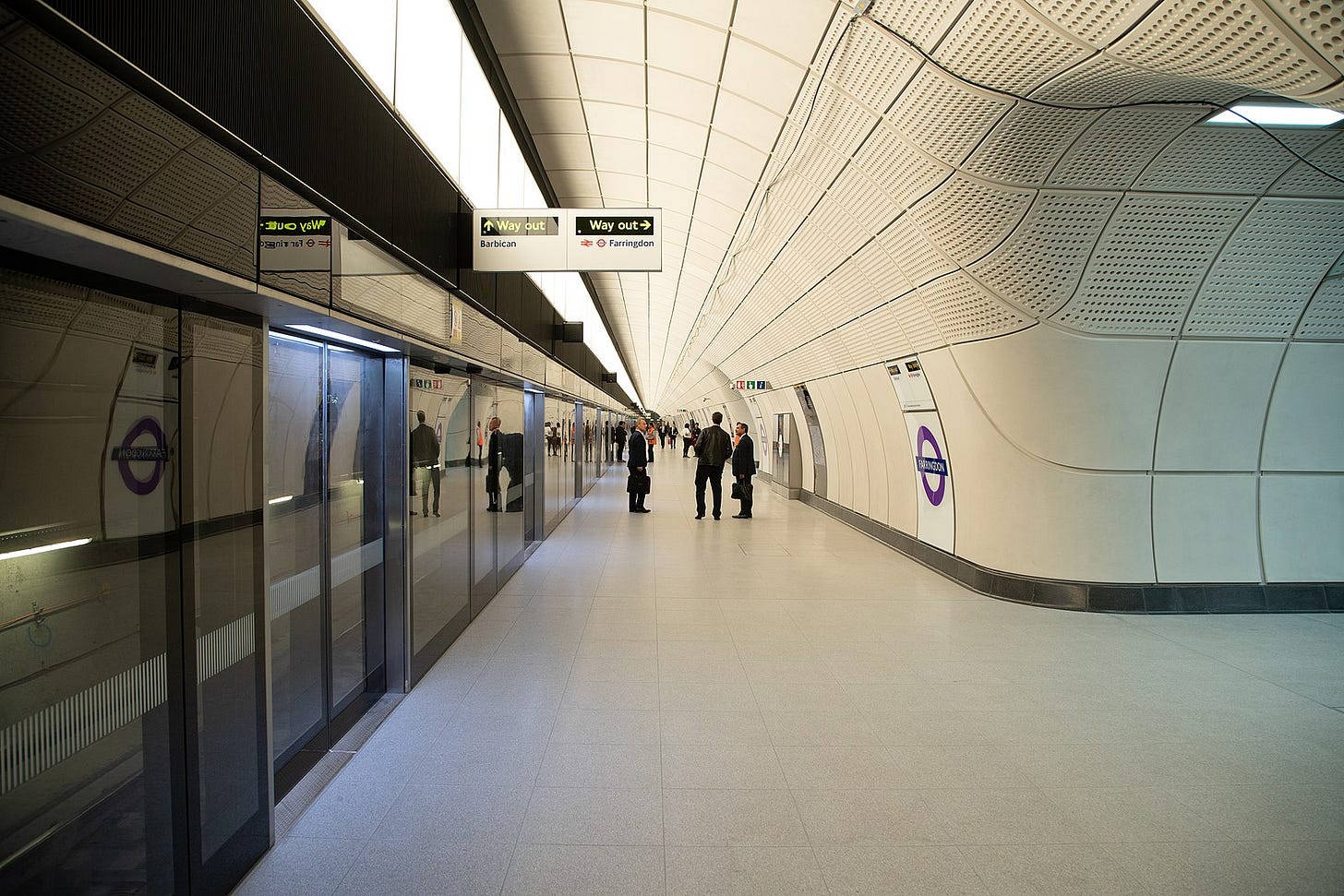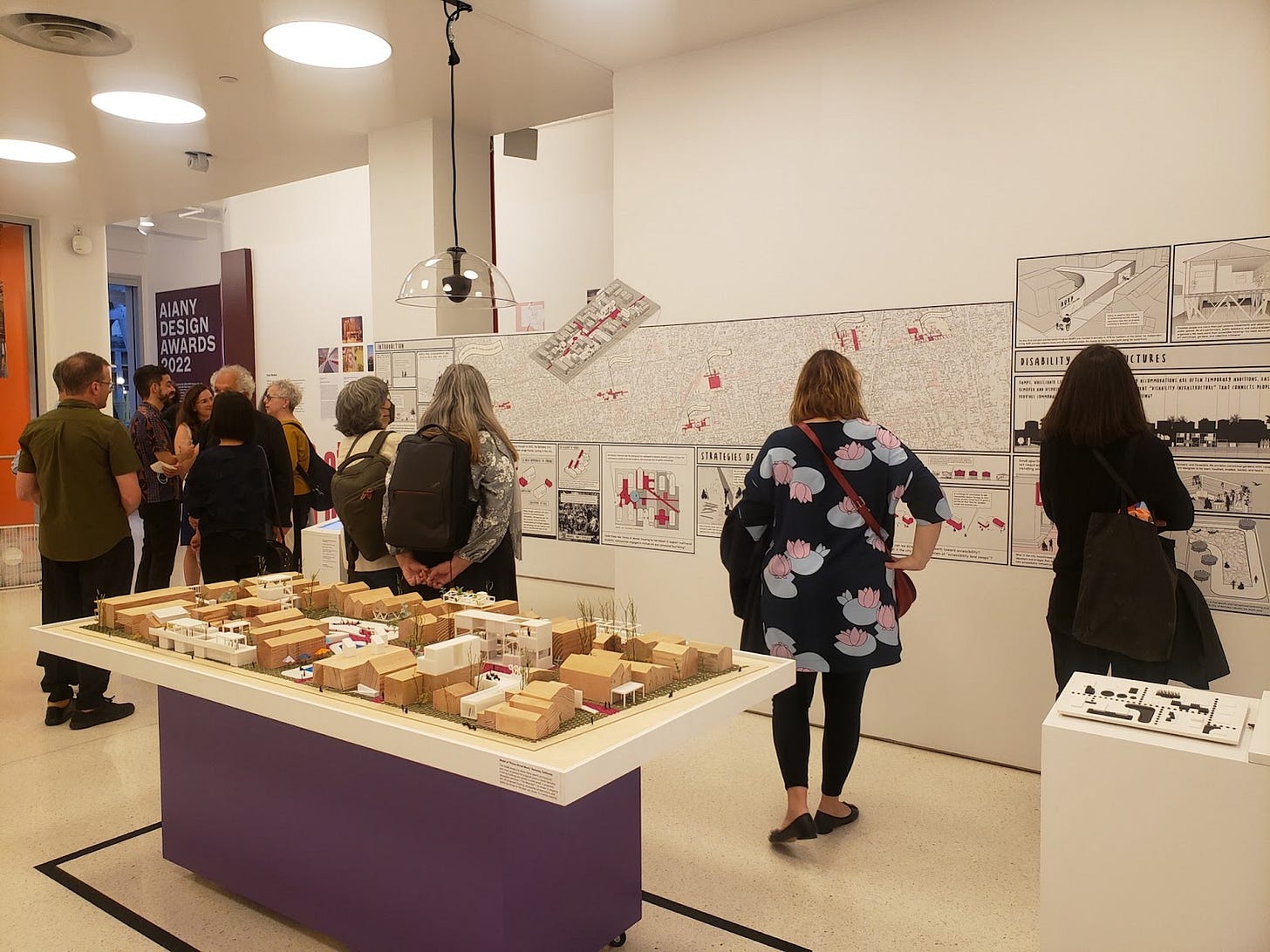Issue 65. This week The Architectural Review reviewed our printed monthly: “all killer no filler.” Don’t believe them. Think for yourself. Subscribe today, and make your own call.
The Surrealists, and many after them, explored new aesthetic dimensions through their parlor game cadavre exquis. This week, NYRA proposes a parlor game of our own. To play, pick one good building, one bad building, and one ugly building, then make your claim to the nearest friend/critical sparing partner. Too easy, you say? Trying choosing three works all by the same designer/office, all within the same locale, or all finished in the same year.
Think of this as the FMK of architectural criticism. We’ve started the first game below, with three contributions, and we hope you’ll join in too.
— Nicholas Raap
GOOD, BAD, UGLY BUILDINGS

GOOD: Brooklyn Central Library (1940, Githens & Keally)
"While men have wit to read and will to know, the door to learning is the open book." - Inscription over the front entrance to the Brooklyn Central Library
As its form suggests, Central Library is open for the community, with a variety of spaces for free public programming, community engagement, and of course, reading.
BAD: On Prospect Park (2008, Richard Meier & Partners)
“The naked steel girders go/up in hubris steps […] Gone the haven of brick and stone and wood,/gone the primal niche of interiority.” - Poem by Ruth Dropkin, neighbor.
A Brooklyn vanguard of the sort that exposes the folly and threat of residential starchitecture, as well as the interior lives of its occupants.
UGLY: Grand Army Plaza (original design 1867, Olmsted & Vaux)
The footprints of labor are everywhere visible, and although the leveled walks, broad drives, closely-cropped grass, heavily-dressed trees, and broad lakes are not visible, yet even the incipiency of all these is interesting to persons at all awake to public enterprise […] The western half of this plaza is now graded and needs only the the hard-gravelled surface or the pavement to be ready for carriages.” - Brooklyn Daily Eagle, 20 June 1867
A critical junction between the borough’s flora and frenzy, it would do to rethink the Plaza to better cater to pedestrian traffic, rather than that of automobiles.
— Anna Talley
GOOD: The Jewel at Changi (2019, Safdie Architects)
Considering it increased the commercial footfall of an airport terminal, it did its job, all while becoming one of the most “Tik-Tok”ed buildings during a pandemic.
BAD: The Marina Bay Sands (2011, Safdie Architects)
The iconic hotel structure has low-priced rooms that face blank walls and providing no view of the bay it overwhelms.
UGLY: Raffles City Chongqing (2020, Safdie Architects)
Perhaps a sister to the Marina project (they share sky decks), the massive building may remind an observer of an imposing hand reaching out from the river. That is ugly.
— Ekam Singh

GOOD: Westminster Cathedral (under construction since 1895, John Francis Bentley)
BAD: 5 Broadgate (2015, Make Architects)
UGLY: Crossrail (under construction since 2009, lead designers Grimshaw Architects)
— Adam Nathaniel Furman
DISPATCHES
4/9: Needing more Nuance
Nuance and Intimacy in Civic Space, a symposium at the Cooper Union
ASTOR PLACE—On Saturday morning, a range of architectural practitioners gathered in the COOPER UNION’s Arthur A. Houghton Jr. Gallery, for the “Nuance and Intimacy in Civic Space” symposium, accompanying an exhibit of the same name.
“Do you mind if I stand?” CATHERINE ANN SOMERVILLE VENART asked as she hovered behind the table. The event tech cautioned, “People won’t be able to hear you.” Somerville Venart simply shrugged, half-heartedly adjusted the microphone, and began to read mostly inaudibly from a paper about the Netherlands, rural and city life, flows of capital, and “preserving the face... but not... beyond the face.” In her slide deck, she displayed landscape paintings and inscrutable flow charts about slavery and social relations, then spoke of some alchemical process involving a feather and the moon.
This presentation was midway through the first panel, allegedly engaging questions of “ethics” in architecture. Most of this panel attempted to address historic racialized wrongs of six centuries of colonialism. LAILA SEEWANG and URI WEGMAN presented a trail, arboretum, and memorial in Portland, Oregon as a corrective to policies that have harmed local Indigenous and Black communities. SOTIRIOS KOTOULAS presented at a clip an Indigenous-focused project for Winnipeg, Canada which incorporated the cosmos, “electromagnetic tonalities,” and a collaborative decision-making structure.
The exhibition and symposium were organized in memory of DIANE LEWIS, who taught at Cooper for decades. In a speech on Lewis’s pedagogy, PETER LYNCH emphasized her generous teaching style, one based on embracing the urbane and the complexity of urban life. I’d never met Lewis or encountered her work, but she seemed like an inspiring thinker and teacher. However, as engaging as Lewis's pedagogy seems to have been, the symposium didn't leave me with any clue as to what nuance or intimacy in architecture looks like or means. In the third presentation, HOLGER KLEIN insisted that "intimacy" need not be concerned with what is small and cozy, that the intimate might also gesture towards the infinite (?!?!): "It is good when humans are confronted by the void."
— Kevin Ritter
4/15: Do you Build Bad?
Launch of “Building Bad: How Architectural Utility is Constrained by Politics and Damaged by Expression” at Cornell AAP
ITHACA (via ZOOM)—A book title like Building Bad: How Architectural Utility is Constrained by Politics and Damaged by Expression may initially sound in favor of aesthetic mandates like the failed executive order Make Federal Buildings Beautiful Again, but in his Thursday afternoon talk, JONATHAN OCHSHORN, professor at Cornell University, clarified that his book's politics refer more to economic pressures than style. To Ochshorn, slashed construction budgets and code-breakers make the conditions for building bad. At their most polite, bad buildings have leaky roofs and mold issues. At their worst they collapse or spread fire, like at Twin Parks in the Bronx, Grenfell Tower in London, or the Champlain Towers in Surfside, Florida. Modernism, he pressed, was the rupture point that led us to design without deeply considering the ramifications of atypical construction, ultimately creating a death drive to the bottom of utility. What began with LE CORBUSIER’s freedom of form through piloti, the open plan, and flat roofs, led up to work like FRANK GEHRY’s phantasmagoric MIT Stata Center and the lawsuits over its issues with drainage, mold, leaks, and ice. With cost and pressure to create novel designs pushing architects from opposite ends, is there any way to build good?
Ochshorn responded to this question by arguing that with enough testing, any buildings could have proper utility and be considered good, no matter how extravagant. He considers these as global architectural problems, arguing that most architects are unlikely to give up any “freedom of design." But looking globally, and expanding Ochshorn’s frame, work of practices like Burkinabé architect FRANCIS KÉRÉ or French architects ANNE LACATON and JEAN-PHILIPPE VASSAL—all recent Pritzker Prize winners—offer designs done with both elegance and utility. In other words, the possibility for both a functional and expressive architecture is not a future pipedream, it's just next door.
— Angie Door
4/15: Resetting the definition of “good” architecture
Opening of 'Reset: Towards a New Commons' at the Center for Architecture
GREENWICH VILLAGE—This Thursday, the CENTER FOR ARCHITECTURE opened Reset: Towards a New Commons, an exhibition of work by four teams that questions the “good” that architecture can do in uniting marginalized communities. Curated by BARRY BERGDOLL, historian and professor at Columbia University, and JULIANA BARTON, Director of Northeastern University’s Center for the Arts, the projects proposed by the four teams—“Block Party”, “Decolonizing Suburbia,” “Re:Play,” and “Aging Against the Machine” — developed prospective environments for multiracial disabled communities, commoning in the aftermath of suburbia, participatory design, and collective agency, among other topics pertinent to a profession that finds itself in a contemplative moment.
Especially powerful in the exhibition were moments when narratives tied to wider structural issues. The project team for “Aging Against the Machine” tied issues residents of West Oakland face to historical and contemporary narratives. Ultimately, for Reset, “good” is not about an ideal aesthetic quality, but the role that architecture plays as a positive socio-political catalyst. These projects conjured visions of a better life for residents, possible both now and in the long term.
— Charles Weak
NYRA ON THE TOWN
4/8: When is a place “original?”
Opening “The Absolute Restoration of All Things” at Storefront for Art and Architecture
SOHO—The hottest spot in town last Friday was at STOREFRONT FOR ART AND ARCHITECTURE, where architects and artists packed the opening of The Absolute Restoration of All Things by MIGUEL FERNÁNDEZ DE CASTRO and NATALIA MENDOZA, the fifth installment of Storefront’s Building Cycles exhibition series. The title plays on the legal language of a 2014 Mexican court ruling which ordered the Penmont Mining Company, to restore the site to “its original state” after illegally extracting 14,795 lbs of gold from the Sonoran Desert site. But what is this original state? The Mexican artists’ work, produced after five years of research, takes the legal language as their premise to dive into the site’s history of transformations and question its presumed neutral condition; from border disputes to wars, illness to smuggling, and a long history of gold mining, though none to the extent of the latest ransacking. Along with artifacts from the site, the formwork used to built a 13 cubic foot rammed earth cube at the bottom of the mining pit, equivalent to the amount of extracted gold to be retuned, was reassembled at Storefront to offer a sense of scale to the disproportionate devastation of the mining operations. When the wine ran out and the accompanying film in the back was no longer audible from all the chatting, the crowd spilled out onto the sidewalk of Kenmare St. where I spotted FRIDA ESCOBEDO, DOMINIC LEONG, MARK WASIUTA, and a few others. ANDRÉS JAQUÉ later shared an Instagram story; he had visited earlier.
— Osvaldo Delbrey Ortiz
EYES ON SKYLINE
Last week, many readers sought to debunk their internalized myths about architecture’s work culture with this Archinect Op-Ed.
IN THE NEWS
This week,
…the Pritzker Military Archives Center, one of Helmut Jahn’s final designs, progresses in Wisconsin…
…for the same site, Oyler Wu was selected to design a memorial…
…Charles and Ray’s granddaughter launched the Eames Institute of Infinite Curiosity…
…AIA New York awarded research grants to four projects, all led by women…
…Theaster Gates and Prada launched a “think tank for talent,” Dorchester Industries Experimental Design Lab…
…and ahead of Earth Day, an author of the Mitigation of Climate Change report from the UN’s IPCC derided the building industry’s lack of action.
DATELINE
In the week ahead,
Monday, 4/18
Designing for the Pluriverse: Restor(y)ing Life, Remaking Worlds with Arturo Escobar
4:30 PM | Cornell AAP
FOODTOPIA: después de todo territorio with Las Nietas de Nonó
6:00 PM | MoMA PS1
Lecture with Dorte Mandrup-Poulsen
6:30 PM | Columbia GSAPP
The Masterplan with Reinier de Graaf
9:30 PM | UCLA Architecture and Urban Design
Tuesday, 4/19
Harvard Design Magazine #50 Issue Launch
12:30 PM | Harvard GSD
Good, Well, and Better with Piergianna Mazzocca
1:30 PM | University of Texas Austin Architecture
Conservation, Ecology, and New York Tech’s New BRIC Building with Jeanne Gang
3:45 PM | New York Institute of Technology
Person Place Thing with Deborah Berke, Randy Cohen
6:00 PM | AIA New York
The Case for the Polychromatic City in 19th Century Paris with Barry Bergdoll
6:30 PM | Yale School of Architecture
From Bauhaus to Passive House with Bruce Redman Beckman
7:00 PM | The Glass House; New Canaan Library
Mapping the Colonial Continuum with Léopold Lambert
7:00 PM | Cooper Union
Wednesday, 4/20
Ambasz Earth Day Lecture with Kunlé Adeyemi
5:00 PM | Museum of Modern Art
Street Futures: How Covid-19 has Changed our Streetscapes
5:30 PM | The New School
Thursday, 4/21
Beyond the Envelope: Coop Himmelb(l)au with Wolf D. Prix
12:30 PM | New York Institute of Technology
Towards Computational Design For and With Bio-Materials with Martin Tamke
1:30 PM | California College of the Arts
Lina Bo Bardi: Material Ideologies
6:00 PM | Princeton School of Architecture
Draw Love Build: The Ahmad Tehrani Symposium with Matthias Sauerbruch, Louisa Hutton, Mark Wigley
6:00 PM | MIT School of Architecture + Planning
John Portman Lecture: Bruther with Stéphanie Bru, Alexandre Thériot
6:30 PM | Harvard GSD
Names of New York: Mapping the Infinite City with Joshua Jelly-Schapiro
6:30 PM | Yale School of Architecture
Friday, 4/22
Writing the History of the Built Environments of Asia: Materiality, Translations, and Colonialism
12:00 PM | Cornell AAP
Robert A.M. Stern’s Journey in Architecture: A Conversation with Barry Bergdoll, Robert A.M. Stern
6:00 PM | AIA New York
Conference: WRITING ARCHITECTURAL HISTORY with Lucia Allais
6:30 PM | Columbia University GSAPP
Our listings are constantly being updated. Check the events page regularly for up-to-date listings and submit events through this link.
LETTER TO THE EDITOR
Have a take, good, bad or otherwise? Write us a letter!
NYRA is a team effort. Our Deputy Editor is Marianela D'Aprile, our Editors at Large are Carolyn Bailey, Phillip Denny and Alex Klimoski, and our Publisher is Nicolas Kemper.
To pitch us an article or ask us a question, write to us at: editor@nyra.nyc.
For their support, we would like to thank the Graham Foundation and our issue sponsors, Tod Williams Billie Tsien Architects and Thomas Phifer.
To support our contributors and receive the Review by post, subscribe here.






